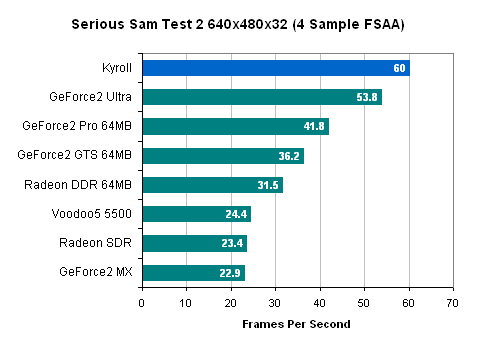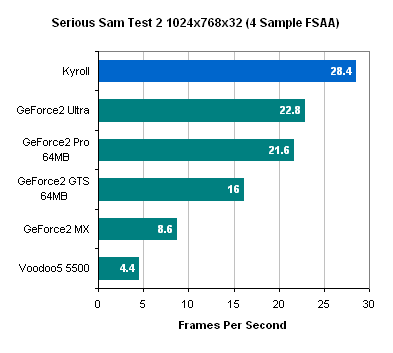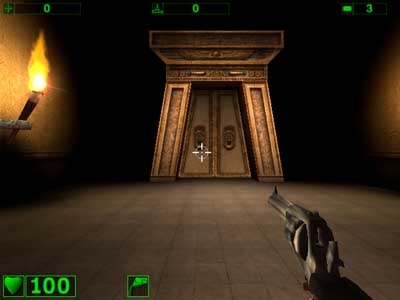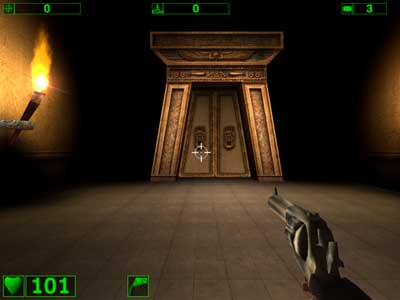FSAA Image Quality and Performance
The Kyro II is able to do up to 4x super-sampling FSAA, however the drivers provided with our card only allowed FSAA mode to be turned on under OpenGL. Let's see how the Kyro II looks with FSAA on and off under Serious Sam.
The results are comparable to NVIDIA's FSAA 2x2 image quality. Note the smooth edges of the door when in FSAA mode. For the full effect, it is necessary to view the images full screen.
Now turning to Serious Sam to provide us with FSAA scores, let's see how the Kyro II does when having to render each frame at four times the resolution.

It is clear that the Kyro II maintains its performance advantage in Serious Sam with FSAA enabled. Once again, the Kyro II is able to out perform the GeForce2 Ultra, this time by 12%. Running at 60 frames per second, the Kyro II is nothing short of amazing.

Of the cards that could make it up to 1024x768x32 with FSAA 4x enabled, the Kyro II once again comes out on top. Beating the GeForce2 Ultra by 25%, the Kyro II is extremely fast.
The reason that the Kyro II is able to perform so well with FSAA enabled is due to the efficiency of the card. In a traditional card, when a scene is rendered at 4 times the resolution to provide 4x FSAA, memory bandwidth is the limiting factor. With the Kyro II, however, memory bandwidth is not a limitation, allowing the card to perform very will when FSAA is turned on.












4 Comments
View All Comments
MonkeyPaw - Monday, February 24, 2014 - link
Thanks for the stroll down memory lane (by keeping the article up). I had one of these cards back in 2002, and it was one I looked back upon fondly. I can't remember most of the GPUs I owned from yesteryear, save the Voodoo 3 and the crappy S3 Verge. That's fairly elite company, at least in my brain, anyway. :)xrror - Monday, March 2, 2015 - link
Yea, it's sad that there wasn't any further development of the Kyro series in the PC market. If I remember right (probably needs fact checked) Imagination's development resources got sucked into the Sega Dreamcast after this point. Even that wouldn't have been so bad if Sega hadn't just given up on the Dreamcast so early on due to a "poor showing in Japan" (nevermind everyone loved it in the US but we didn't count apparently, also see Genesis/MegaDrive).I think Imagination or at least their tech lives on in the embedded/mobile space now, but meh - really wanted to see what they could have done with their tech without being shackled to a power budget in 2002-2005 era PC's.
Alexvrb - Wednesday, October 14, 2020 - link
You're wrong. The Dreamcast was designed years earlier using PowerVR Series 2. The later "Kyro series" was based on Series 3. The DC design win netted them some much needed cash which they used to fuel their Series 3 releases. What killed imgtech was their inability to play well with others (board partners) and issues staying on schedule for releases. If they had managed to get the 4800 out the door sooner, and released the larger Kyro III with DDR it would have bought them some time. Especially if they had paired it with a hardware T&L block like Elan.thegreatjombi - Wednesday, August 12, 2015 - link
Its very interesting to think that Imagination Technologies could have been another foot note in history (3dfx, bitboys Oy! Rendition..) but going mobile and refining their technology has allowed them to basically become more popular than ATI(AMD) or Nvidia. There are probably more devices in peoples houses running a powervr variant than have an AMD or Nvidia GPU.I do wish someone would stick their chip on a discrete card again, they apparently support full Directx and OpenGL! could be an interesting low profile, low end, low power, fanless card for HTPCs.